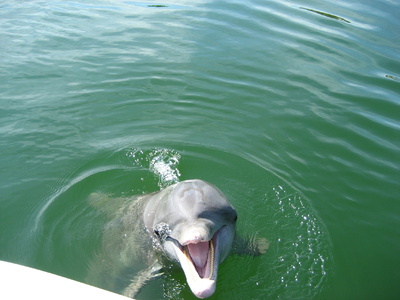 This past Friday September 21 the beloved "Beggar" the dolphin was found floating in the Intracoastal Waterway near the Albee Road Bridge to Casey Key. Beggar, named for his constant begging for food and attention from boaters for the past 20 years has been a Sarasota icon and a natural tourist attraction for boaters near the Albee Road Bridge. This bottled nose dolphin could be seen daily in the no-wake zone swimming up along side every boat looking for a free hand out. Feeding and petting dolphins is punishable with up to a $100,000 fine and possible up to a year in jail under the Marine Mammal Protection Act.
This past Friday September 21 the beloved "Beggar" the dolphin was found floating in the Intracoastal Waterway near the Albee Road Bridge to Casey Key. Beggar, named for his constant begging for food and attention from boaters for the past 20 years has been a Sarasota icon and a natural tourist attraction for boaters near the Albee Road Bridge. This bottled nose dolphin could be seen daily in the no-wake zone swimming up along side every boat looking for a free hand out. Feeding and petting dolphins is punishable with up to a $100,000 fine and possible up to a year in jail under the Marine Mammal Protection Act.
"Beggar was a local icon and tourist attraction for over two decades, and the results of this necropsy are a reminder of how people's actions are harmful to wild dolphins," said Stacey Horstman, NOAA Fisheries Bottlenose Dolphin Conservation Coordinator in a statement. "There is a common misconception that feeding, touching, and swiming with dolphins is not harmful and that they don't get hit by boats. We are concered about how frequently the public and anglers continue to feed wild dolphins, as Beggar is just one of many wild dolphins in the southeast U.S. that have been fed by people and learned to associate people with food." as reported by the Saraosta Patch.
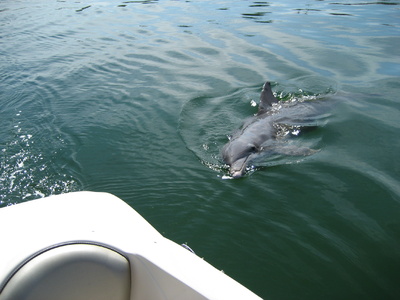
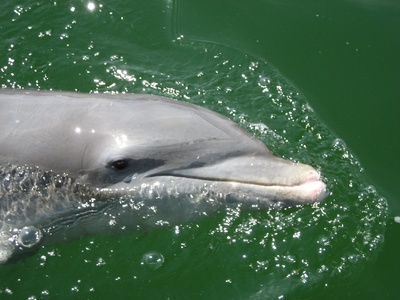
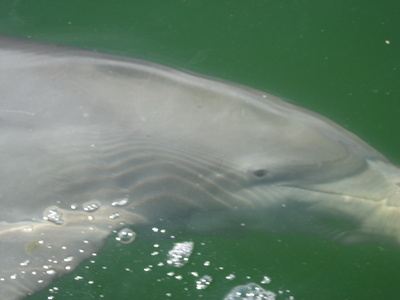
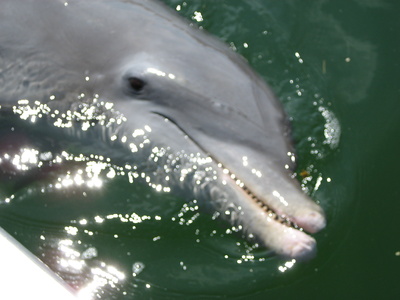
Underwater Times. com reported the following,
Posted by Sara Leicht - SaraSellsSarasota.com onGretchen Lovewell, manager of Mote's Stranding Investigations Program, performed a necropsy, or animal autopsy, on Beggar Friday evening. The animal's body was in a state of moderate decomposition and no definitive cause of death could be pinpointed. However, there were numerous findings indicating that his interactions with humans played an overall role in Beggar's ill health.
- Externally, there were healed boat wounds on the dorsal fin, a healed puncture wound on the right pectoral fin, a possible boat wound on the right side of the body, below the dorsal fin and a healing puncture wound between the blowhole and the dorsal fin.
- Beggar had multiple broken ribs and vertebrae.
- While he did not have much food in his stomachs, there were three fishing hooks and small bits of line in the first stomach, two squid beaks (not a normal prey item for resident Sarasota Bay dolphins) and several ulcers of varying severity in the third stomach.
- He was dehydrated — possibly because he was not eating a normal dolphin diet.
In addition to these wounds, Lovewell also found internal injuries from two stingray barbs. One barb had migrated through the ribs and embedded near the small intestine with necrotic tissue surrounding the barb. The second barb was found near the right shoulder blade and was very close to puncturing the thoracic cavity (near the lungs).
"We can't say which of these many injuries was the ultimate cause of death for Beggar," Lovewell said. "But all of our findings indicate that he was in poor health for a long time and that his interactions with humans played a role. Boat strike wounds, fishing hooks and line in his stomach — even the squid beaks we found — all of these things indicate that he was spending more time attempting to get food from humans than foraging on his own."
Beggar had been frequenting the area where he was found dead for more than 20 years. From March to June 2011, Dr. Katie McHugh of the Sarasota Dolphin Research Program, a partnership between Mote and the Chicago Zoological Society, spent 100 hours observing his behavior and that of the boaters who encountered him. She documented:
- 3,600 interactions between Beggar and humans — up to 70 per hour;
- 169 attempts to feed him 520 different food items — everything from shrimp and squid to beer, hot dogs and fruit;
- 121 attempts to touch him — resulting in nine bites to the humans doing the petting.
"Compared to the other wild dolphins we study in Sarasota Bay, Beggar was not a healthy dolphin," McHugh said. "In addition to his unnatural feeding behavior, Beggar also had very limited social interactions with other dolphins and moved over an extremely small range when compared to most adult male dolphins."
Leave A Comment